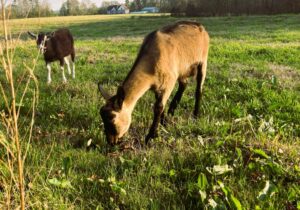
Windbreaks A wide aspect detailed illustration of agricultural windbreaks. The scene shows rows of tall trees strategically planted along the edges of agricultu 1.webp.webp

Windbreaks
Definition:
Windbreaks, also known as shelterbelts or wind barriers, are linear plantings of trees, shrubs, or other vegetation strategically positioned to protect crops, livestock, and soil from the damaging effects of wind erosion. Windbreaks serve as natural barriers that reduce wind speed, prevent soil erosion, conserve moisture, and create microclimates conducive to agricultural productivity.
Practical Advice:
- Selecting Windbreak Species: Choose appropriate tree and shrub species for windbreak plantings based on local climate, soil conditions, and intended objectives. Select species with dense foliage, deep root systems, and tolerance to wind, drought, and pests to maximize windbreak effectiveness and longevity.
- Designing Windbreak Layout: Design windbreak layouts considering factors such as prevailing wind direction, field orientation, and desired protection objectives. Position windbreaks perpendicular to prevailing winds to maximize wind reduction, and vary the height and density of plantings to create effective wind barriers and microclimate zones.
Valuable Assistance:
- Establishing Windbreak Maintenance: Implement regular maintenance practices to ensure the health and effectiveness of windbreaks over time. Prune trees and shrubs to maintain desired height and density, control weeds and invasive species, and monitor for pests and diseases to prevent damage and preserve windbreak functionality.
- Enhancing Biodiversity: Incorporate diverse species composition within windbreak plantings to enhance ecological resilience and provide additional benefits such as wildlife habitat, pollinator support, and biodiversity conservation. Mix deciduous and evergreen species, include flowering plants and grasses, and create habitat niches to promote ecological balance within windbreaks.
Enlightening Details:
- Minimizing Soil Erosion: Windbreaks play a critical role in reducing soil erosion by intercepting windborne sediment and reducing wind velocity near the ground surface. The dense canopy of trees and shrubs helps trap airborne particles, stabilize soil, and prevent soil loss, preserving soil fertility and agricultural productivity.
- Conserving Moisture: Windbreaks contribute to moisture conservation by reducing wind evaporation and transpiration from crops and soil surfaces. By creating sheltered microclimates, windbreaks decrease water loss through evaporation, increase water retention in soil, and improve overall water use efficiency in agricultural systems.
Actionable Suggestions:
- Planning Windbreak Placement: Plan windbreak placement strategically to maximize benefits and minimize potential drawbacks. Consider factors such as field accessibility, equipment maneuverability, and compatibility with existing land uses when siting windbreaks to ensure optimal integration into agricultural landscapes.
- Engaging in Collaborative Efforts: Collaborate with neighboring landowners, conservation organizations, and government agencies to implement large-scale windbreak projects and landscape-scale conservation initiatives. Pool resources, share expertise, and coordinate efforts to establish extensive windbreak networks that benefit multiple stakeholders and ecosystems.
Conclusion:
Windbreaks are valuable tools for protecting agricultural lands, enhancing ecosystem resilience, and promoting sustainable land management practices. By integrating windbreaks into farm landscapes, farmers can mitigate the adverse effects of wind erosion, conserve soil and water resources, and create resilient agricultural systems capable of withstanding environmental challenges.
Fall off the barn roof and busted your keister? Life on the farm or ranch can be tough on the bum. Need a break? Laugh it off at FarmerCowboy.com, the #1 farm humor site. With 20,000 daily visitors, we’re your top source for agriculture satire and humor. Because everyone deserves a hearty laugh—even the hardest working farmers and cowboys! Join us and turn those long days into fun tales at FarmerCowboy.com.

Originally posted 2011-04-05 18:27:24.
Originally posted 2024-06-22 03:49:31.
Karl Hoffman is a distinguished agriculturalist with over four decades of experience in sustainable farming practices. He holds a Ph.D. in Agronomy from Cornell University and has made significant contributions as a professor at Iowa State University. Hoffman’s groundbreaking research on integrated pest management and soil health has revolutionized modern agriculture. As a respected farm journalist, his column “Field Notes with Karl Hoffman” and his blog “The Modern Farmer” provide insightful, practical advice to a global audience. Hoffman’s work with the USDA and the United Nations FAO has enhanced food security worldwide. His awards include the USDA’s Distinguished Service Award and the World Food Prize, reflecting his profound impact on agriculture and sustainability.





